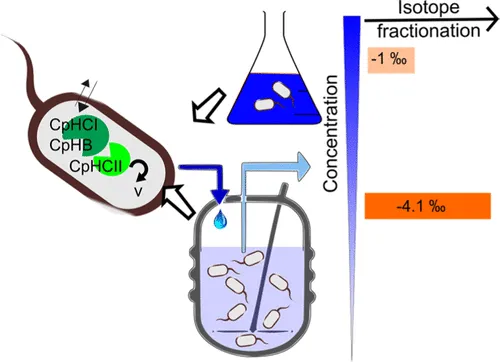K. Kundu, A. Melsbach, B. Heckel, S. Schneidemann, D. Kanaparthi, S. Marozava, J. Merl-Pham, M. Elsner
Environmental Science & Technology (2022)
Abstract
Slow microbial degradation of organic trace chemicals (“micropollutants”) has been attributed to either downregulation of enzymatic turnover or rate-limiting substrate supply at low concentrations. In previous biodegradation studies, a drastic decrease in isotope fractionation of atrazine revealed a transition from rate-limiting enzyme turnover to membrane permeation as a bottleneck when concentrations fell below the Monod constant of microbial growth. With degradation of the pollutant 4-chlorophenol (4-CP) by Arthrobacter chlorophenolicus A6, this study targeted a bacterium which adapts its enzyme activity to concentrations. Unlike with atrazine degradation, isotope fractionation of 4-CP increased at lower concentrations, from ε(C) = −1.0 ± 0.5‰ in chemostats (D = 0.090 h–1, 88 mg L–1) and ε(C) = −2.1 ± 0.5‰ in batch (c0 = 220 mg L–1) to ε(C) = −4.1 ± 0.2‰ in chemostats at 90 μg L–1. Surprisingly, fatty acid composition indicated increased cell wall permeability at high concentrations, while proteomics revealed that catabolic enzymes (CphCI and CphCII) were differentially expressed at D = 0.090 h–1. These observations support regulation on the enzyme activity level─through either a metabolic shift between catabolic pathways or decreased enzymatic turnover at low concentrations─and, hence, reveal an alternative end-member scenario for bacterial adaptation at low concentrations. Including more degrader strains into this multidisciplinary analytical approach offers the perspective to build a knowledge base on bottlenecks of bioremediation at low concentrations that considers bacterial adaptation.
